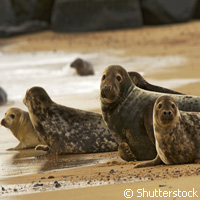Management plans to help boost Baltic Sea seal and cod numbers
Grey seals (Halichoerus grypus balticus) and cod may have swum in close quarters in the Baltic Sea a decade ago, but this is no longer the case. The heavy decline in their numbers has forced them apart; the remaining grey seals populate the northern parts of the Baltic while the cod has found a niche in the southern parts. New research, funded in part by the EU with a combined support of more than EUR 23 million, shows how management plans could help boost both these populations in the Baltic Sea, enabling a mix back into the fold, where the cod could resurge in the northern parts and the grey seals could make their way south again. The findings, published in the journal PLoS ONE, suggest that fisheries and climate change will have a heavier impact on the cod than on the grey seals. 'Since the grey seal and cod populations could overlap in the future, we investigated whether the management plans to re-establish the populations of cod and grey seals are contradictory, since there is a chance that the grey seals can harm the cod stocks as happened in the [1920s and 1930s],' explains Professor Brian MacKenzie of the National Institute of Aquatic Resources (DTU Aqua) in Denmark. 'Although, back then the grey seal population was much larger than it is now,' adds the lead author, who collaborated with Margit Eero, also from DTU Aqua, and Henn Ojaveer of the Estonian Marine Institute on this study. The stock of cod in the Baltic Sea was hit 10 years ago by decreased salinity, over-exploitation and depletion of oxygen. However, scientists and the fishing industry have observed a rise in cod numbers since the mid 2000s, brought on by solid years of cod reproduction and a fishing management plan with effective regulation of the fisheries. 'The environmental conditions of the Baltic Sea are still not perfect,' says Professor MacKenzie, 'but fishing levels are low at the moment, giving the cod a chance to rebuild the population. This has given rise to an increase in cod numbers during the last four to five years.' The current level of cod fishing is sustainable. However, the experts note it is crucial to tackle other ecosystem issues that could impact the cod population in the future. This is why researchers are now focusing on the grey seal. 'Historically, seals have affected cod stocks, and in many areas they are suspected of being the reason why the recovery of cod stocks has been delayed,' Professor MacKenzie says. 'Therefore, it was important to determine whether the grey seals could pose a threat to the cod stock in the Baltic Sea.' Besides the grey seal, the experts believe climate change could trigger a drop in the salinity of the Baltic Sea, affecting the cod's ability to reproduce - their eggs and larvae will be affected by higher mortality numbers. Cod numbers will also be affected by fishing, but this activity can be regulated based on the cod population numbers. They say regulating climate changes and seal behaviour is not feasible. So adjusting fishing levels to other factors affecting the stocks of cod is key; only if other factors are identified can this happen. 'If the Baltic Sea experiences lower salinity due to climate change, the cod stocks will most likely suffer because the cod will have difficulty reproducing,' Professor MacKenzie explains. 'Furthermore, there will be predation by grey seals. These two ecosystem issues can greatly affect the cod stock, so this is why we wanted to find out how large these impacts might be in order to regulate fishing levels accordingly,' he adds. The team made various simulations of future scenarios, observing that fishing and environmental factors like oxygen depletion and decreasing salinity will influence cod more than grey seals in the future. These the first simulations for the cod population in the Baltic Sea that include both the increasing population of grey seals as well as the possibility that climate change will decrease the salinity of the Baltic Sea, according to the researchers. Grey seals will be able to hunt for cod when needed, but they won't harm the cod population in the process, they note. The study was funded in part by three EU projects: UNCOVER, BONUS+ and VECTORS. UNCOVER ('Understanding the mechanisms of stock recovery') was supported under the Policies Cross-Cutting activity of the EU's Sixth Framework Programme (FP6) to the tune of EUR 3.7 million. BONUS+ and VECTORS are both supported under the Seventh Framework Programme (FP7). BONUS+ ('Multilateral call for research projects within the Joint Baltic Sea Research Programme') has clinched an ERA-NET grant worth EUR 7.27 million, while VECTORS ('Vectors of change in oceans and seas marine life, impact on sectors') is backed with EUR 12.48 million under the Environment Theme. //CPA For more information, please visit: DTU Aqua: http://www.aqua.dtu.dk/English.aspx(opens in new window) PLoS ONE: http://www.plosone.org/home.action(opens in new window)
Countries
Denmark, Estonia



